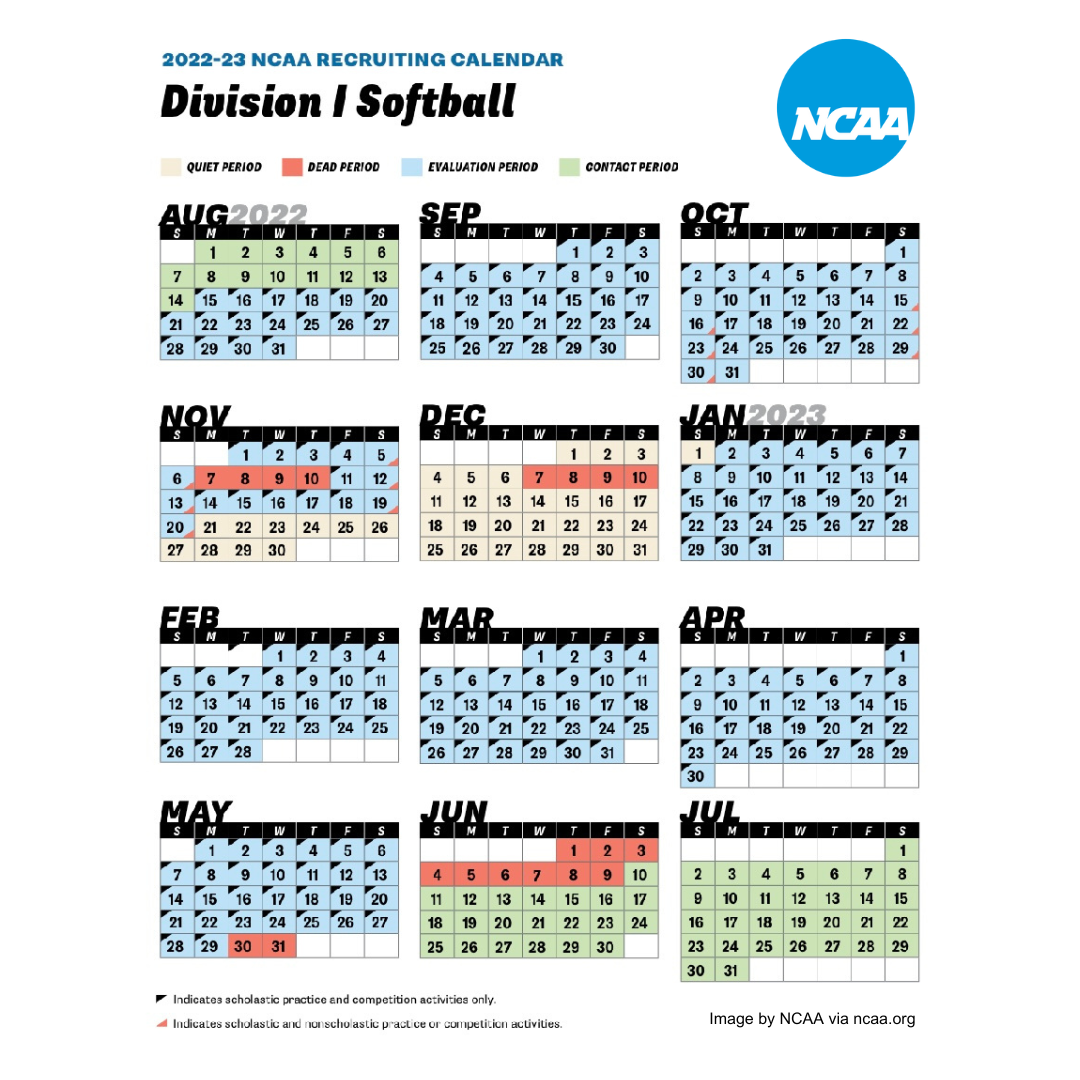NCAA Softball Recruiting Calendar: Why It Matters
Hello fellow softball players! As a female athlete who has gone through the college recruiting process, I know firsthand how confusing and overwhelming it can be. That’s why I want to share with you the ins and outs of the NCAA softball recruiting calendar. To play softball at the next level, it’s important that student-athletes, softball parents, and your travel ball and high school coaches have a good grasp on the different periods within the recruiting calendar. Understanding these periods and dates is essential so you can maintain eligibility and start building relationships with the college softball coaches who head up the programs you’re interested in. Note that nearly all NCAA Division I women’s sports have a recruiting calendar, including women’s basketball, volleyball, soccer, track and field, and more. What I’ve outlined here are the important recruiting periods and the recruiting calendar for high school softball players.
A Look at the Different Recruiting Periods
Let’s start by diving into the different recruiting periods for college softball. There are four main periods: the contact period, the evaluation period, the quiet period, and the dead period. During the contact period, college softball coaches can contact high school student-athletes both on and off-campus. The evaluation period is when college coaches can watch players compete in person, but cannot have any off-campus contact. The quiet period is when coaches can only communicate with prospective student-athletes on their college campus. Finally, the dead period is where college coaches cannot have any contact with student-athletes. These periods are typically around holidays and other important dates throughout the year, like the Women’s College World Series (the women’s softball championship for NCAA Division I softball).
Here’s a recap of the recruiting periods:
· Contact Period - college coaches can contact high school student-athletes and their parents through NCAA-approved communication channels such as email, text messages, direct messages and phone calls
· Evaluation Period - college coaches can watch players compete in person at tournaments or other competition activities or visit them at their school or home, but there are specific recruiting rules about where coaches can evaluate athletes
· Quiet Period - college coaches can only communicate with prospective student-athletes while both parties are on their college campus (or via other approved electronic communication methods)
· Dead Period - college coaches cannot have any in-person contact with student-athletes or their families, but can keep in touch though phone, email, and social media
Softball Recruiting Calendar: The Nitty Gritty
In 2018, in order to curb early recruiting, the NCAA implemented more stringent regulations for Division I softball coaches. These regulations prohibit DI coaches from initiating any communication related to recruiting with prospective players, their parents, current coaches, or any other intermediaries before September 1st of the player’s junior year of high school.
Despite these stricter regulations that limit the communication between coaches and athletes, it is still allowed - and definitely advisable - for athletes to take the initiative and be proactive in the recruiting process. This approach is even more critical than before, given that once September 1st arrives, college coaches will be eager to reach out to eligible athletes, and it is essential for prospects to ensure they are on their list of potential recruits. Reaching out to college coaches in your freshman year and sophomore year will allow you to be on coaches’ radars early.
In addition to the different recruiting periods, there are also official and unofficial visits. Official visits are paid for by the college and can only happen during a high school student-athlete’s senior year. Unofficial visits are visits to a college campus that are paid for by the student-athlete or their family, and those can happen after September 1 of the athlete’s junior year. During official visits and unofficial visits, you can have face-to-face contact with the coaching staff, meet the current team of softball players, and get to know the campus and program better.
Zeroing in on the Next Level of Softball
When going through the softball recruiting process, it’s important to showcase your athletic ability, your intentions, and both your scholastic and non-scholastic practices when connecting with the coaching staff at colleges you’re interested in attending. In other words: Let them get to know you and all that you’re bringing to the table. You can do this through face-to-face contact at visits, camps and tournaments, as well as through phone calls, as long as you are within the contact rules of the recruiting calendar, as outlined above. College softball coaches and other staff members want to see that you’re not only a talented player, but also a good fit for their team and program.
Finally, when you’ve found the right college and program for you, it’s time to sign the national letter of intent (for players entering schools at the Division I and Division II level). This legally binds you to the college and ensures that you’re eligible to play at the next level. Note, players entering a Division III college, junior college or NAIA program do not sign a letter of intent.
Overall, understanding the NCAA recruiting calendar and the different recruiting periods is essential for college-bound student-athletes who are in high school. Make sure to stay on top of the different periods and eligibility guidelines, take advantage of official and unofficial visits, and showcase your athletic ability to make the most of your college recruiting experience. Good luck on your journey through the recruiting process all the way to playing college softball!

